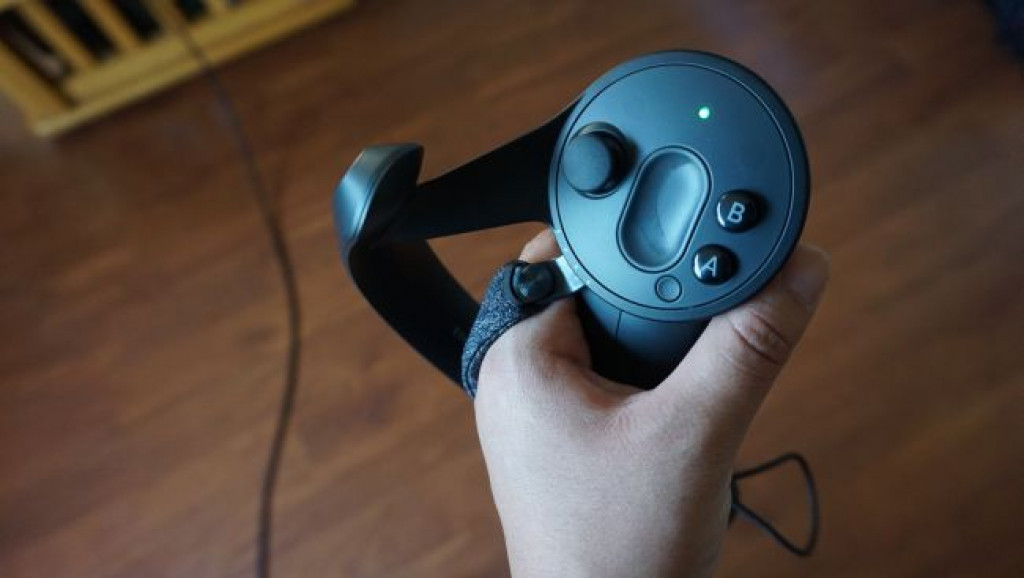
EARLY VERDICT
After spending a weekend with it, there’s little doubt that the Valve Index is the next-generation VR headset we’ve been waiting for. But at $999 (£919, about AU$1,425) for the full package, Valve’s new five finger-tracking headset might be out of reach for most VR enthusiasts.
FOR
- Wider field-of-view
- ‘Knuckle’ Controllers
- Room-scale VR
- Great audio
AGAINST
- Still uses base stations
- Lackluster game selection
- Glasses do get in the way
After spending a weekend with it, there’s little doubt that the Valve Index is the next-generation VR headset people have been clamouring for: It has an ultra-crip display that runs fairly well even with older GPUs, a wider field-of-view and Valve’s knuckle controllers that can track the movement of every finger.
All said, it’s the complete VR package that we wanted three years ago.
But the future of VR is inevitably expensive – the Valve Index is $999 (£919, about AU$1,425) – and before we go on painting Valve’s hardware as the savior VR needs right now, it’s worth pointing out that it’s not without issues (see: a lack of compelling VR games on Steam and VR’s love-hate relationship with those of us who wear glasses).
But is any of that enough to ruin Valve’s VR headset? Not at all.
Design
It’s easy to write-off the Valve Index as another non-descript VR headset in the same vein as any Oculus Rift or HTC Vive headset – but the devil’s all in the details here: On the front, there’s a glossy plastic faceplate above two front-facing cameras that can be used for passthrough video and, potentially, AR applications. Go to put the headset on and you’ll feel the stone gray pads that line the inside. It’s a similar Halo design to what Oculus is doing on the Rift S and it feels both comfortable and snug.
To keep it that way, there are two dials that you’ll need to use – one on the left side that changes the physical distance from the lens to your eyes, and the one on that back that makes the headband tighter or looser. While the second is definitely important, it’s something we’ve seen before. It’s the first dial that’s actually groundbreaking as that’s what allows the Index to get its industry-leading field-of-view spec.
How does it do that? The science of this is pretty self-explanatory, but basically the closer a screen is to your face, the wider the field-of-view. The problem here is that, for folks who wear glasses, you won’t be able to get the lenses right up to your eyes – and that means using a similar field of view to the other headsets out there.
In terms of hard numbers, the Valve Index uses a dual LCD display with a 1440×1600 resolution per eye. Unlike Oculus that has actually dropped the refresh rate of its displays for the Oculus Rift S, the Valve Index has a 120Hz display with the ability to be bumped up to 144Hz. For comparison, the more-expensive Vive Pro has a lower refresh rate and smaller field-of-view, so this actually feels like a big upgrade.

Inside the box you’ll find the headset itself, the new Valve Index Controllers (colloquially referred to as the ‘Knuckle’ controllers) and the Version 2.0 Base Stations that need to be set up around your room.
Now, if you have a Vive or Vive Pro headset already, the first-gen base stations are compatible with the Valve Index – but you’ll probably want to start with the second-gen stations if you don’t have a pair already.
We won’t dwell on them, but the fact that the Vive Index uses base stations at all feels like a step backwards, even if the end-result it a good one. Using external trackers puts it behind the Oculus Rift S – which does room-scale VR without any external tracking sensors that need to sit on a shelf – however, the base stations that the Valve Index uses seem much, much better at tracking. Case in point: At no point during our hands on time did the system lose track of the controllers. Obviously, that could change with more use, but so far, so good.

Performance
Amazingly, while all these features would seem to require extra horsepower under the hood of your PC, they actually worked fine with our much-older Nvidia GTX 980 GPU. That’s a boon for folks who don’t have the money to upgrade their GPU after buying a $1,000 VR headset, and could allow for more people than ever to get into VR.
That last bit is important, because as more people adopt VR, more developers will see a business opportunity in making VR games. As of right now, Steam’s VR selection is a bit bare compared to the ever-expanding main store and even the top titles selected by Valve to show off the new hardware are really just a lot of old titles that play better with the Knuckle controllers (see: Space Pirate Trainer, Fruit Ninja, Beat Saber and Arizona Sunshine).
That said, when we played some newer titles – like Valve’s Moondust demo – we couldn’t help but smile. Not only do the games look great on the high-resolution screen, and play without any hitches even on our less-than-ideal hardware, but they feel more interactive with the Index Controller. Being able to release items by opening your hand – a completely natural experience here in the real world – feels unnatural at first after using regular VR controllers for the last two years, but once you adapt to it, it once again becomes second nature.

There’s also sound quality to consider. The Valve Index uses a built-in solution that, for all intents and purposes, works incredibly well. You’re able to hear a great number of details without distortion, and even though it’s an inch from the ear, it can still get reasonably loud. It also feels a bit more hygenic when it comes time to pass the headset to another person – as your ears never make contact with the pads – though that’s a really minor detail.
Over the course of a two three-hour sessions we were able to get a lot accomplished – we played a bit of Beat Saber’s campaign, chopped some fruit in Fruit Ninja and wrecked some robots in Space Pirate Trainer – and through it all the controllers held their charge. At the end of the last day the controllers dropped down to a single bar of life, but a safe assumption is to expect around five hours of playtime before you need to recharge the controllers.
Early verdict
Our early impression of the Valve Index is a great one. We feel like it’s the second-generation of VR, and one that raises the bar for virtual reality… for folks who can afford to shell out around $1,000 on a VR headset.
We’ll continue to test out the headset over the next month, and post a final review once we’ve had some more hands on time with Valve’s VR hardware.
Source: techradar.com









































